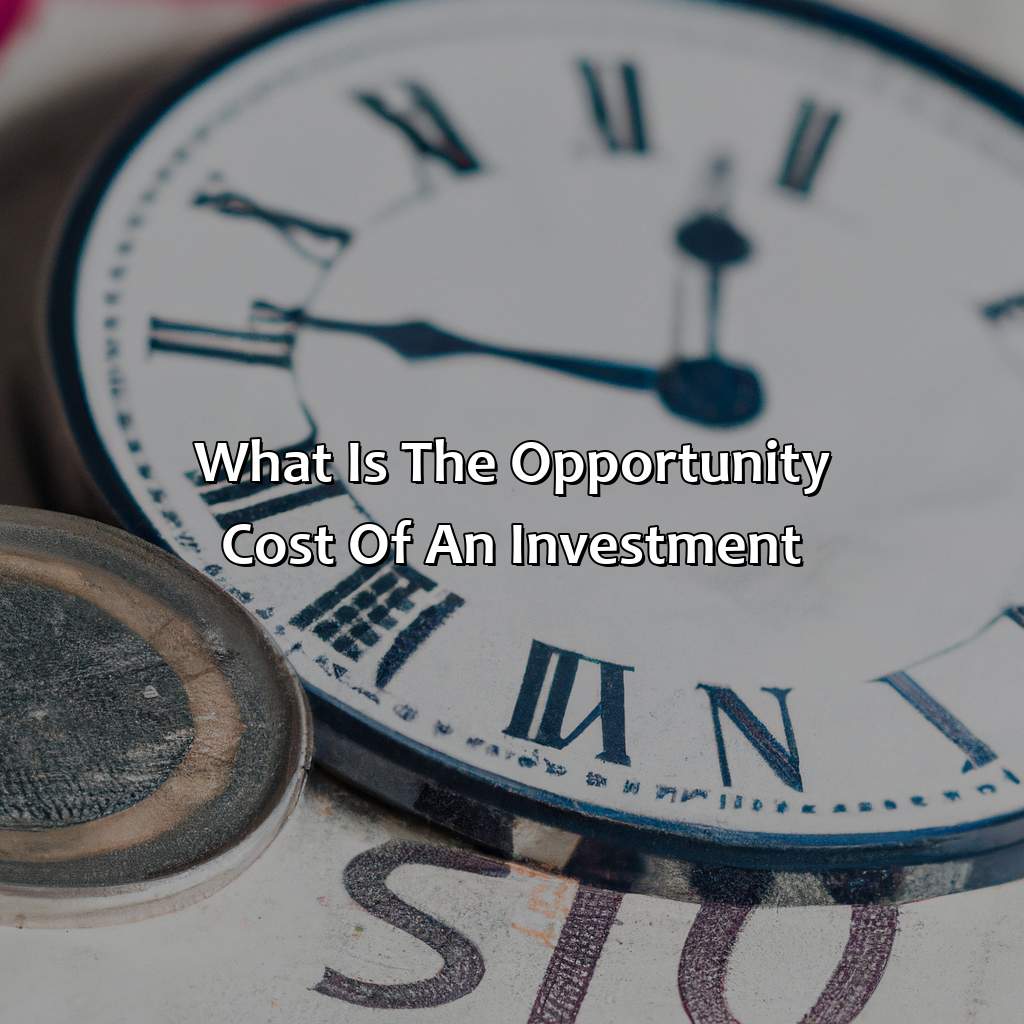What Is The Opportunity Cost Of An Investment?
Key Takeaway:
- Opportunity cost is the cost of an alternative forgone when investing in a certain option. It is the value of the next best alternative that must be given up.
- There are different types of investments, including financial, time, and effort investments. Each type has a different opportunity cost that must be considered when making investment decisions.
- The importance of opportunity cost in investment lies in its ability to help investors make optimal decisions, manage risk, and maximize profits. Failing to consider opportunity cost can lead to suboptimal outcomes and missed opportunities.
Investing can be an intimidating process, especially when considering the time and money you could be spending elsewhere. Have you ever stopped to think about the opportunity cost of an investment? You don’t want to miss out on potential rewards this decision could bring. Discover the true cost of investing.
What is Opportunity Cost?
You need to learn the definition of opportunity cost and how to calculate it to get a full understanding of investments. This will help you make better decisions when picking between options. We’ll explain what opportunity cost is and how to calculate it in this section.
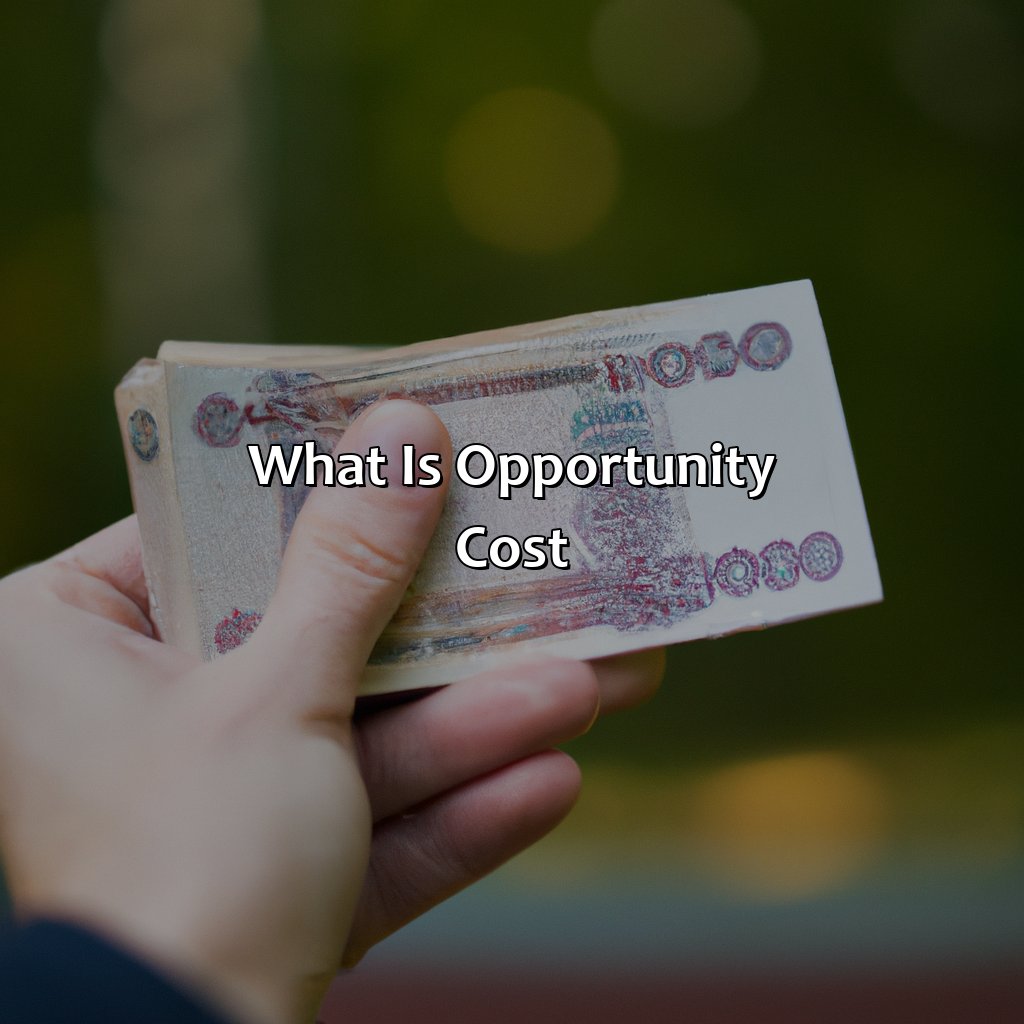
Image credits: retiregenz.com by Joel Arnold
Definition of Opportunity Cost
Opportunity cost is the value of an alternative that must be forgone in order to pursue a certain action or investment. It is the cost incurred from not choosing the next best alternative. Understanding and considering opportunity cost is essential in making rational and informed decisions, especially when dealing with limited resources.
In simple terms, opportunity cost means sacrificing one option for another. For example, if investing in stocks yields a return rate of 8% while investing in bonds yields 4%, the opportunity cost of investing in bonds would be 4%. This lost potential earnings could have been earned if you had chosen to invest in stocks instead.
It is important to note that opportunity costs are subjective and differ from person to person, as their perceived value of alternatives may vary depending on individual circumstances and preferences.
Knowing your opportunity costs can help to make better decisions based on ROI (Return on Investment) analysis or any other financial analysis. Fretting about sunk costs (previous investments), which are irrelevant towards future decision-making should be avoided at all costs.
Interestingly, the concept of Opportunity Cost was first introduced by Friedrich von Wieser during the late 19th century as part of his contributions to Austrian economics.
Why did the accountant calculate the opportunity cost? To see if the investment was worth the counting!
Calculation of Opportunity Cost
Opportunity cost is the foregone benefit of an alternative course of action. To calculate the opportunity cost, one needs to evaluate the benefits and costs of each alternative and determine which would provide a greater gain.
Below is a table highlighting the calculation of opportunity cost:
| Investment Options | Benefits | Costs |
|---|---|---|
| Option A | $100 | $50 |
| Option B | $90 | $30 |
To calculate the opportunity cost of choosing option A over B, we subtract the benefits of option B from those of option A and add the costs of option B:
Opportunity cost = (Benefits of Option A – Benefits of Option B) + Costs of Option B
= ($100 – $90) + $30
= $40
It is important to note that other intangible factors like risks and uncertainties should be considered when evaluating investment options.
Pro Tip: Accurately calculating opportunity cost requires thorough research and analysis. Consider all possible outcomes before making a final decision.
Why invest in one type of opportunity cost, when you can diversify and experience the pain of multiple losses?
Types of Investment
Learn about types of investments in the article “What is the opportunity cost of an investment?” Discover financial, time and effort investments. Get to know the impact of each on the opportunity cost of your investment. Understand the importance of every type of investment.

Image credits: retiregenz.com by Harry Washington
Financial Investment
Investments can offer the potential to earn returns on money that would otherwise be idle. Investors often diversify among different types of investment in order to spread risk and take advantage of varying economic conditions. By choosing to invest in various funds, stocks or commodities, investors embark on a financial journey that comes with risks and gains.
Different investment vehicles carry varying degrees of risk and reward potential. Some investments may yield higher returns, but only after years of holding them, while others may present quick and significant gains, for example. Equally one should consider the different tax implications involved depending on your country of residence.
Realistic assessments regarding an investment opportunity’s performance are valuable points to consider before investing. This involves reaching a perspective by studying factors across diverse industries, such as analysing company financial statements from quarterly reports or reviewing market trends against historical data.
The stock market crash of 1987 was the largest since 1929’s Black Tuesday events were triggered by computerized trades made based on portfolio insurance strategies that had never been tested under volatile market conditions.
Time is the only investment that you can never get back, but at least it’s not taxed…yet.
Time Investment
Investing your time in a specific activity or task can prove to be valuable and profitable. This type of investment is known as Temporal Investment and involves allocating your time to receive returns in the long run. Effective time management and planning are key to making the most out of this investment.
Proper planning and prioritization can help you reap maximum rewards. Time investments require patience, perseverance, hard work, and dedication. A strategic approach and focus on enhancing your skills while working towards achieving goals can ensure better outcomes.
Effective utilization of your time can result in improved work-life balance, personal growth, increased productivity, financial stability, and career advancement opportunities.
Historical accounts reveal that renowned leaders invested a considerable amount of their time to develop their skills and enhance their knowledge. The likes of Bill Gates, Elon Musk, Steve Jobs spent countless hours learning new things which ultimately helped them achieve great success in their respective fields.
Therefore, it’s important to value every moment you spend investing in yourself or pursuing an opportunity. Time is a finite resource; make sure you use it wisely to achieve long-term benefits.
When it comes to effort investment, remember: time and energy may be renewable resources, but your sanity is not.
Effort Investment
Investment of Effort – How Much Are You Willing to Give?
Investment of effort is a crucial aspect of investment, where you invest your time and energy in achieving your goals. It requires focus and dedication towards attaining specific objectives while considering the opportunity cost involved. Opportunity cost refers to the benefits that one sacrifices for choosing an alternative option while investing time and effort.
When investing effort, one needs to identify the risks and rewards involved in the task at hand and analyze whether it aligns with their long-term goals. Investing effort can lead to increased skill development, professional reputation, and higher earnings if done correctly.
It’s essential to note that not all investments of effort yield immediate results, which can affect an individual’s motivation levels. Hence it’s beneficial to break down bigger tasks into smaller achievable goals that contribute to overall growth in the long run.
Understandably, if limited resources are available, individuals may need to decide between two probable opportunities, leading them towards fear of missing out (FOMO). Hence it’s always wise to discuss investment decisions with professionals who have relevant expertise.
Opportunity cost may sound like a boring economics term, but it’s the Cliff Notes version of figuring out whether that Lamborghini is worth investing in.
Importance of Opportunity Cost in Investment
Understand opportunity cost’s importance in investing. It affects decisions, risk management and profit gaining. Look into these areas for insight. Opportunity cost is key to optimizing investments.
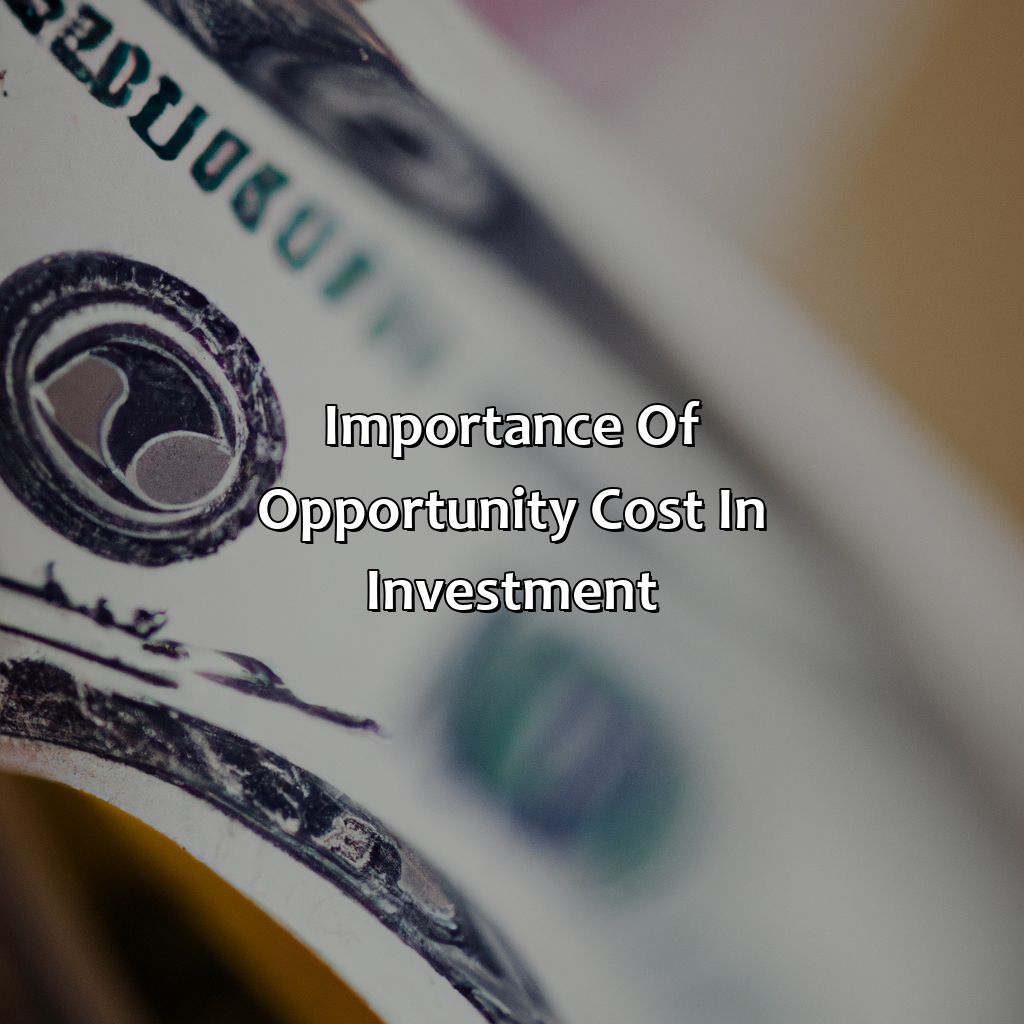
Image credits: retiregenz.com by Joel Arnold
Decision Making
Making Informed Decisions in Investment
Investing involves numerous decisions, and making the right ones can be challenging. To ensure that an investment decision results in a profitable outcome, investors must analyze all possible alternatives. Careful consideration of opportunity cost is an essential part of making informed investment decisions.
Opportunity cost refers to the value of an alternative option forgone when choosing one investment over another. It focuses on what must be sacrificed or given up to attain something else. By considering opportunity cost, investors can determine whether a particular investment is the best option compared to other available alternatives.
Moreover, opportunity cost analysis allows investors to weigh their options and decide which investments will provide the most significant return on their money. Understanding opportunity cost helps avoid sunk costs and enables decision-makers to focus on the future benefits that any given alternative may present.
Therefore, before taking a step forward with an investment decision, ensure you have thoroughly analyzed all available options while weighing their respective opportunity costs. Don’t let FOMO make you rush into uninformed decisions; instead, take your time and make strategic choices based on informed evaluations of risk vs reward in different investment opportunities.
Risk management is like wearing a seatbelt while driving – it might not be fashion-forward, but it sure is necessary.
Risk Management
Managing risk in investment is critical and involves strategies that mitigate losses and encourages profit. Proper mitigation requires a firm understanding of potential risks, market trends, and financial insights. Analyzing the correlation between such factors ensures secure positions in investments while aiding diversification towards tangible earnings. Sudden changes or fluctuations within markets can result in significant losses, highlighting the importance of risk management – the art of anticipating and mitigating foreseeable risks to profits.
The variety of risks associated with investments includes operational risks, legal risks, credit risks, market risks, and reputational risks, to name a few. Mitigating these dangers urges strategic approaches that are uniquely scalable based on individual investment types. The ability to manage these risks effectively maximizes return on investment while minimizing potential pitfalls.
Risk management dominates the finance sector’s operations due to its importance for safeguarding investors’ capital and ensuring profitable returns. Investors must embrace timely analysis continually using techniques such as risk quantification methods and statistical modelling to stay ahead of investment threats. By employing various necessary strategies regarding managing risk during investments curated through insightful analyses ensures building portfolios free from loosing trades bringing stability and confidence.
Maximizing profits is like finding a needle in a haystack, except the needle is made of solid gold and the haystack is made of money.
Maximizing Profits
Generating Maximum Returns for Investment
Investors put money in an investment to generate maximum returns. Maximizing profits is the ultimate goal, and investors seek opportunities to capitalize on profits from investments.
The following are some factors that can help in identifying profitable investments, maintaining a diversified portfolio, reducing investment risks through financial analysis and capitalizing on growth potential factors of investment markets:
- Identifying profitable investments
- Maintaining a diversified portfolio
- Reducing investment risks through financial analysis
- Capitalizing on growth potential factors of investment markets
Considering factors such as economic conditions, taxes, volatility, interest rates, inflation, government policies or changes that affect investment yields are critical elements that generate maximum yield.
One can evaluate the historical performance and use technical analysis to predict future movements. Investors get insights on market trends and learn how to minimize risk which is inherent in every venture. For instance take Apple’s stock which went public on December 12th, 1980 with each share priced at $22. As of August 2nd, 2021, the share price is $146; a growth ratio of over 600%. By analyzing historical data, it would have been possible to make predictions about Apple®’s growth trajectory from inception till date.
If you invest all your money in avocado toast, the opportunity cost might be a house with no toast.
Examples of Opportunity Cost in Investment
Understand opportunity cost in investment? Examples help us comprehend it. Let’s investigate specific investments, like real estate, stock and education. Knowing the opportunity cost of each investment helps us make smart financial decisions in the future.
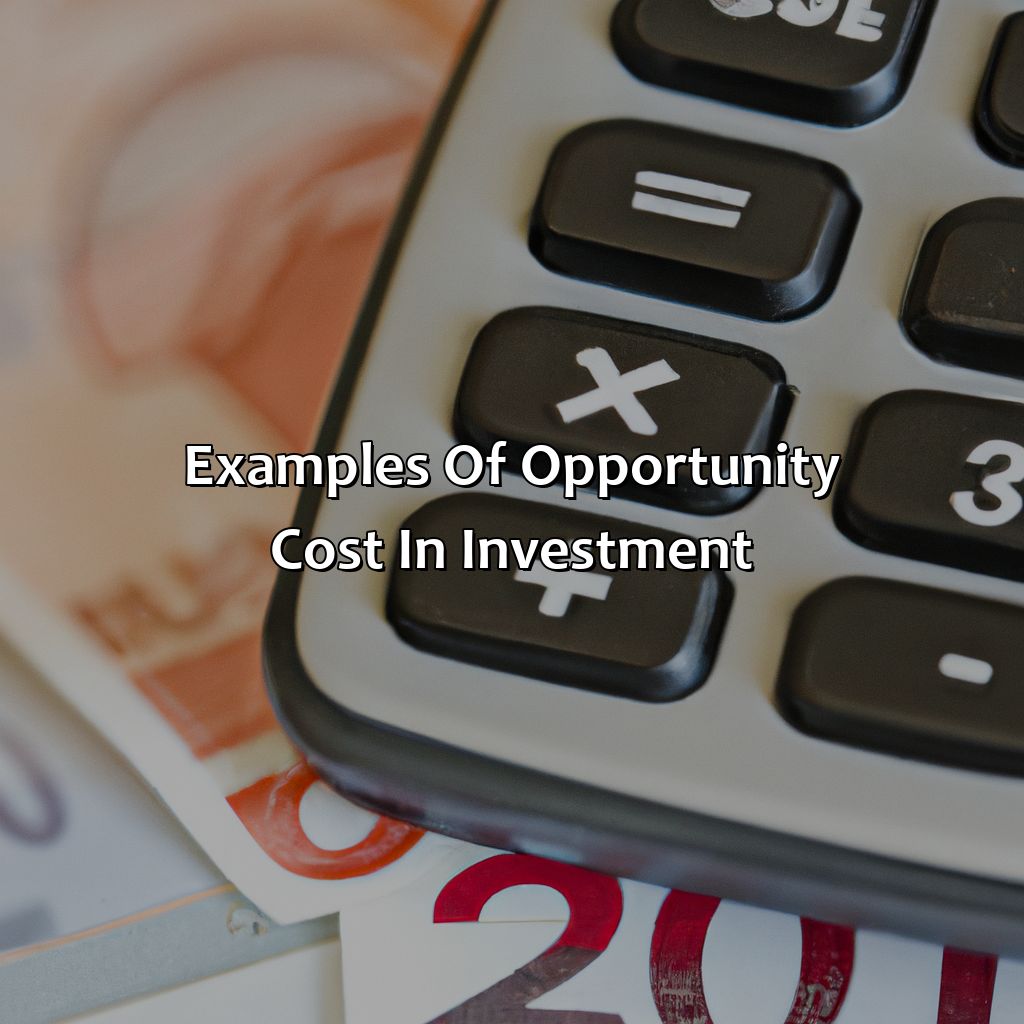
Image credits: retiregenz.com by James Woodhock
Real Estate Investment
Investing in properties that generate income is a smart financial move as it has high return potential. However, the opportunity cost of real estate investment is the potential profit from an alternative investment. Maintaining cash flow and equity appreciation are important factors to consider while investing in real estate. Additionally, keeping an eye on market trends like rental demands and building maintenance can help make informed decisions for profitable investments. A Bloomberg study shows that Real Estate Investment Trusts (REITs) outperformed the S&P 500 index returns from 1999-2019.
Just remember, investing in stocks can be a rollercoaster ride – but at least you won’t have to wait in line for it.
Stock Investment
Investing in Shares:
Stock investment is one of the most popular forms of investing that involve buying and selling shares in a publicly-traded company. Here are four key insights to know about Stock Investment:
- It offers capital appreciation along with dividend income
- While it comes with higher risk, it also has potential for higher returns compared to other investment options
- Investors should have a long-term perspective while making investments in stocks.
- It requires careful portfolio management, as the value of shares rises or falls depending on various market forces.
In addition, stock investors must be aware of and consider the opportunity cost associated with their investment decisions. Opportunity costs are the benefits missed or foregone when choosing one course of action over another. In stock investment, opportunity cost can arise when an investor chooses not to invest time and resources into another potentially profitable venture.
To make wise stock investment decisions, it’s important to take guidance from experienced advisors and conduct thorough research before taking any steps. Diversifying your portfolio, setting achievable goals, and taking a long-term approach are all suggestions that can help maximize returns while minimizing risk.
Looks like I’ll have to choose between getting a degree and getting a new car, because opportunity cost waits for no one.
Education Investment
Investing in one’s education can have significant opportunity cost. By choosing to invest time and money into a specific field, individuals are sacrificing the potential earnings and experiences that could come from investing in alternative fields or opportunities.
Furthermore, education investment may require temporary job loss or reduced work hours, leading to additional opportunity costs in terms of missed wages and experience. However, investing in education can also provide longer-term benefits such as increased earning potential and career opportunities.
Interestingly, the opportunity cost of education investment varies depending on factors such as level of education pursued, type of degree received, and the field one enters. For example, pursuing a master’s degree in business administration may result in higher earning potential and career advancement than a bachelor’s degree in general studies.
One notable example of the opportunity cost of education investment is that of renowned physicist Stephen Hawking. Despite his incredible intellect, he chose to pursue an undergraduate degree in physics instead of mathematics due to his interest in experimental physics at the time. This decision resulted in missed opportunities to pursue advanced mathematics research later on in his career.
Investing is like playing poker, the more factors you consider, the better your chances are of not going all in on a bad hand.
Factors Affecting Opportunity Cost in Investment
To grasp the impact of opportunity cost on investments, three sub-sections should be looked at: Market Conditions, Individual Preferences, and Economic Environment. Each can have a huge effect on how you invest and what the opportunity cost is. Let’s examine these factors more closely and see how they could change your investment strategies.
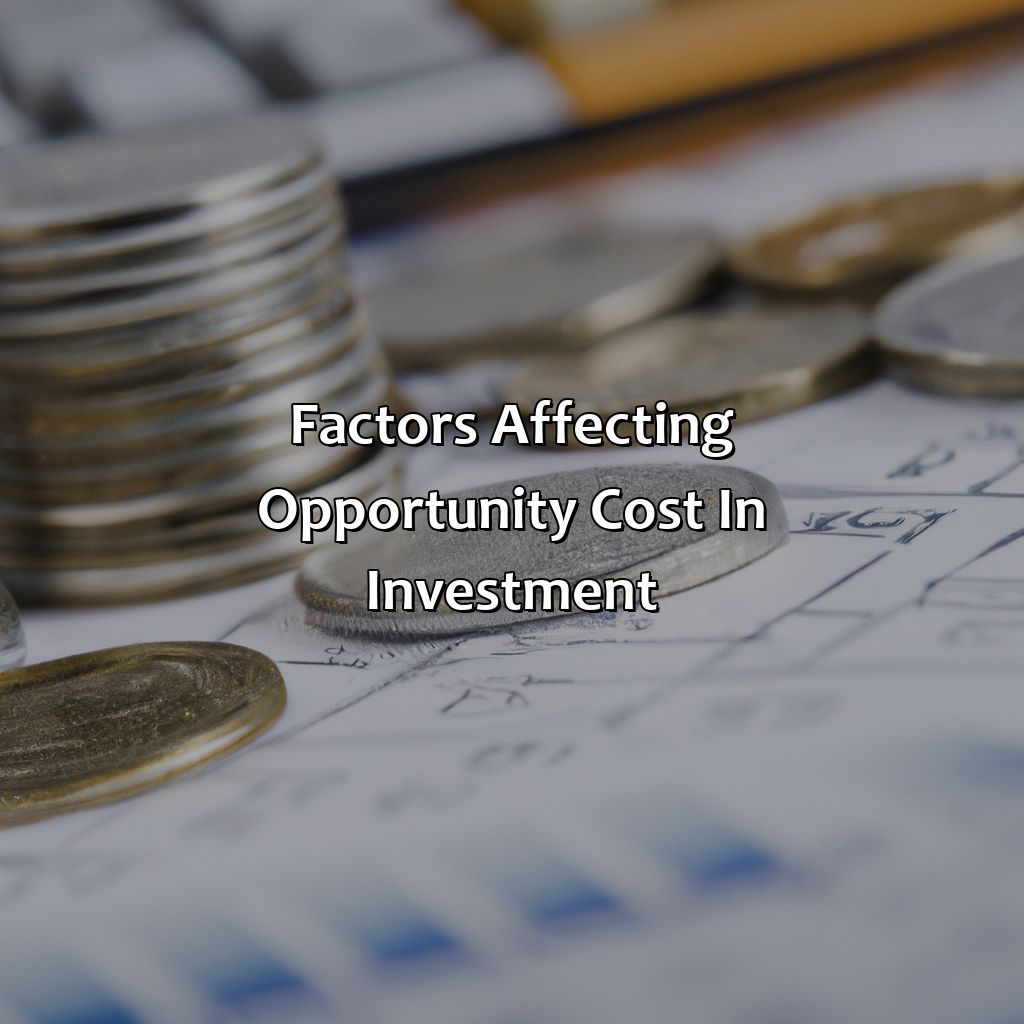
Image credits: retiregenz.com by James Jones
Market Conditions
The investing landscape is shaped by various factors, including the current state of market affairs. The forces that govern supply and demand, political unrest, inflation rates, and economic policies are among the many components that comprise market conditions.
These market conditions can have a significant impact on the opportunity cost of an investment. For example, in a bullish market with high demand and low supply of stocks or real estate assets, the opportunity cost for investing in such assets may be quite high. Conversely, during bearish markets or economic downturns, the opportunity cost for investments may be lower due to lower prices and increased volatility.
It’s important to note that while market conditions play a vital role in determining opportunity cost, they’re not the only factor at play. Investors must also consider other variables such as their risk tolerance level and investment goals when determining the trade-off between different investment options.
Understanding the dynamics of market conditions and their relationship to opportunity cost is crucial for making informed investment decisions. In 2008, when the global financial crisis hit markets worldwide, investors who failed to recognize changing market conditions faced substantial losses despite initially high returns.
In sum, while various factors affect opportunity costs in investments, understanding how market conditions interact with them is essential. Sound decision-making means considering all variables that predict outcomes and making informed choices based on those predictions.
Your individual preferences can make or break your investment, just like how my preference for tequila shots broke my bank account.
Individual Preferences
In investing, personal inclinations – including risk tolerance, values, and beliefs – significantly affect opportunity cost. These factors alter the valuation of potential gains and losses associated with particular investments. The relationship between individual preferences and opportunity cost is especially pronounced when choosing between mutually exclusive investment options.
When determining the opportunity cost of an investment, one must consider various factors. A significant one is the degree of acceptable risk given investor preferences. Additionally, investors’ perceptions about different industries, market trends, and future outlooks impact opportunity cost as well.
It is essential to recognize that individual preferences are highly nuanced and multifaceted, meaning that no two investors will have precisely the same opportunity costs for any given investment option.
Understanding how individuals value their investments empowers them to make smarter financial decisions. However, ignoring these crucial factors or applying a one-size-fits-all approach may result in suboptimal investment returns.
By recognizing this relationship between personal preference and opportunity cost in investing, people can choose an investment that aligns with their goals without suffering from dissatisfactory results in the future.
Make informed investment decisions today by taking into account your unique preferences toward risk-taking and investing. Don’t miss out on better opportunities due to ignorance or lack of awareness about what matters most to you as an investor!
Economic Environment
The economic milieu is a fundamental aspect to consider when making investments. The environment encompasses factors that can both directly and indirectly affect the opportunity cost of an investment. Understanding how these factors affect your investment decisions could save you a lot of money in the long run.
Several macroeconomic indicators, including inflation, interest rates, GDP growth rates, geopolitical tensions and trade policies, directly influence stock prices, bond yields and commodity prices. These indicators dictate market movements which impact your investments’ value and potential returns. In contrast, people’s behaviour towards these indicators affects the psychological mentality of investors and goes on to impact stock prices, real estate prices and other asset values.
One unique detail worthy of mention is considering how sustainability plays an indirect yet imperative role in investing. Investors are now more socially conscious and have begun evaluating companies based on environmental, social and governance (ESG) ratings. Millennial investors indicated that ESG issues play a significant part in their decision-making process as they seek to make positive impacts with their investments.
Don’t miss out on potential returns by ignoring economic indicators or disregarding sustainable investing trends. Being aware of fluctuating markets and incorporating ESG principles can help diversify your portfolio while also supporting important causes.
Five Facts About the Opportunity Cost of an Investment:
- ✅ The opportunity cost of an investment is the potential gain that is given up by choosing one investment over another. (Source: Investopedia)
- ✅ Opportunity cost is a crucial concept in making investment decisions and is used to determine the best option for allocating resources. (Source: The Balance)
- ✅ The opportunity cost of an investment is influenced by factors such as market conditions, investment risk, and the investor’s objectives and time horizons. (Source: Schwab)
- ✅ Understanding opportunity cost helps investors to analyze potential trade-offs in decision making, assess risk, and evaluate the returns of an investment. (Source: Forbes)
- ✅ The opportunity cost of an investment is not always easily quantifiable and may require assessing alternative scenarios and outcomes. (Source: Fidelity)
FAQs about What Is The Opportunity Cost Of An Investment?
What is the opportunity cost of an investment?
The opportunity cost of an investment refers to the potential benefits you could have received by choosing another investment or option instead. It is the cost of foregone opportunities.
How does opportunity cost affect investment decisions?
Opportunity cost affects investment decisions by weighing the potential benefits of one investment over another. Investors must consider what they are giving up by choosing one investment over another, as well as the potential return on investment for each option.
How can I calculate the opportunity cost of an investment?
The opportunity cost of an investment can be calculated by subtracting the potential return on the chosen investment from the potential return on the next best option. This shows how much you are giving up by choosing one investment over another.
What are some examples of opportunity cost in investing?
Examples of opportunity cost in investing include choosing to invest in one stock over another, or choosing to invest in a high-risk high-return option instead of a lower-risk option with lower returns.
Why is it important to consider opportunity cost in investment decisions?
Considering opportunity cost in investment decisions helps an investor make the most informed decision by weighing the potential benefits and drawbacks of each option. It allows an investor to make a decision that maximizes their potential returns.
Can reducing opportunity cost increase investment returns?
Reducing opportunity cost can potentially increase investment returns by allowing the investor to make a more informed decision. By considering the potential benefits of each option, an investor can choose the investment that offers the greatest potential return on investment.
